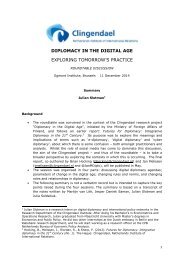SWEDEN%20policy%20profile%20-%20published%2005-02-2013
SWEDEN%20policy%20profile%20-%20published%2005-02-2013
SWEDEN%20policy%20profile%20-%20published%2005-02-2013
Create successful ePaper yourself
Turn your PDF publications into a flip-book with our unique Google optimized e-Paper software.
44 - CHAPTER 3. WHAT ARE THE CHALLENGES AND STRATEGIES?<br />
This chapter aims to identify alternatives Sweden could consider when facing challenges in<br />
curriculum revision and implementation. It first describes common challenges countries are<br />
facing and then presents the different approaches Sweden has been using to tackle the<br />
challenges. Lastly, it identifies strategies undertaken by New Zealand, Norway and Portugal.<br />
Common challenges<br />
The OECD international survey on quality has identified four common challenges that<br />
countries face in designing, revising and implementing a curriculum framework: 1) defining<br />
goals and content; 2) curriculum alignment for continuous child development; 3) effective<br />
implementation; and 4) systematic evaluation and assessment.<br />
Defining goals and content<br />
When designing a curriculum framework, guidelines or standards, the goals of ECEC have<br />
to be defined as well as the actual content of the curriculum. Defining these is a challenge in<br />
many OECD countries due to the different visions of stakeholders on what the curriculum<br />
should aim at and include. Policy makers, researchers, ECEC professionals and parents<br />
consider different subjects to be important, and each has their own cultural values and ideas<br />
about early development. Aligning curriculum goals and contents with the current and future<br />
needs of society at large can be challenging, especially with such changes as increasing<br />
migration and advances in information and knowledge economies.<br />
Most countries set out goals, guiding principles and content in their curriculum framework or<br />
guidelines, explicitly stating the aims of the country’s ECEC services, curriculum, the roles of<br />
different actors involved in ECEC, and the subjects prescribed at the national level. This is<br />
most often a result of intensive consultations with the different stakeholders in ECEC.<br />
Curriculum alignment for continuous child development<br />
Ensuring continuous child development from birth to primary education is a key challenge in<br />
countries with a “split system” where child care and early education are administered by<br />
different ministries. In these countries, a lack of a curriculum framework for children aged<br />
zero to three is often non-existent; or if it exists, is not aligned with the curriculum for children<br />
aged three to six. The rationale of the split system is often attributed to differences between<br />
the two sectors, such as historical roots, different goals and focus on contents.<br />
Ensuring smooth transition from ECEC to primary education is also a challenge in integrated<br />
systems like in New Zealand, Norway and Sweden. Teaching approaches and practices<br />
experienced by children are often disconnected in ECEC settings and compulsory schooling.<br />
Effective communication and implementation<br />
Gaining wide support for curriculum and implementation is a challenge faced by many<br />
countries. Without “buy-in” from those who are to implement a change or a new idea, any<br />
reform may fail. And the “buy-in” or “consensus” cannot be built – without sufficient and<br />
strategic consultation – at the implementation stage.<br />
It is also a challenge to implement the change or new idea without support. The kind of<br />
support required for effective implementation depends on various characteristics of the staff<br />
as well as contexts.<br />
Furthermore, preparing conditions for staff to effectively implement the curriculum is another<br />
challenge. Insufficient guidelines and resources are likely to enhance difficulties, especially<br />
QUALITY MATTERS IN EARLY CHILDHOOD EDUCATION AND CARE: SWEDEN © OECD <strong>2013</strong>








